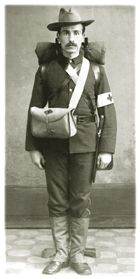The Cost of a Splendid Little War
Spanish-American War
 One hundred years ago, the United States and Spain fought an almost forgotten war, but one with far-reaching effects. The Spanish-American War had its origins in the Cuban Revolution of 1895. A rebellion began when Cuba sought independence from its colonial ruler. The United States government at first remained neutral, but became concerned when the Spanish Governor began forcing thousands of citizens into concentration camps while his forces destroyed the countryside. Because of American business interests on the island and sympathy for the Cuban insurrectos, relations between the United States and Spain deteriorated. Sensationalist U.S. newspapers exaggerated the atrocities committed against the Cubans. Public opinion called for the United States to pressure Spain into granting Cuba its independence. President William McKinley ordered the U.S. Navy to send the battleship
USS Maine
to Cuba as a show of force.
One hundred years ago, the United States and Spain fought an almost forgotten war, but one with far-reaching effects. The Spanish-American War had its origins in the Cuban Revolution of 1895. A rebellion began when Cuba sought independence from its colonial ruler. The United States government at first remained neutral, but became concerned when the Spanish Governor began forcing thousands of citizens into concentration camps while his forces destroyed the countryside. Because of American business interests on the island and sympathy for the Cuban insurrectos, relations between the United States and Spain deteriorated. Sensationalist U.S. newspapers exaggerated the atrocities committed against the Cubans. Public opinion called for the United States to pressure Spain into granting Cuba its independence. President William McKinley ordered the U.S. Navy to send the battleship
USS Maine
to Cuba as a show of force.
At approximately 9:40 p.m. on the evening of February 15, 1898, the battleship Maine exploded in Havana Harbor. The U.S. Navy and Marine Corps suffered 267 casualties. Although the true cause of the explosion has never been determined, the immediate explanation by extremists in the United States was to suggest that the Spanish government was somehow responsible. After unsuccessful negotiations lasting almost four months, President McKinley asked Congress for a declaration of war on April 11, 1898. Two weeks later, war between the United States and Spain was officially declared.
The war spanned the globe. The main battles were in the Spanish colonies of the Philippine Islands, Cuba, and Puerto Rico. In the Philippines, the Spanish were easily defeated in the naval Battle of Manila Bay on May 1. A short time later the U.S. Army landed on the island bringing it under American control.
The campaign in the Caribbean was initially not as successful. Insufficient planning resulted in ill-equipped and poorly-supplied troops. While the Marines came ashore at Guantanamo, Cuba, on June 10th, it took another 12 days before the Army landed an expeditionary force. Nevertheless, by July 17, the Spanish had surrendered. A week later, a United States expedition landed in Puerto Rico. Within three days, most of the island was under American control. On August 1, a cease fire was declared.
On December 10, 1898, the United States and Spain signed the Treaty of Paris, officially ending the Spanish-American War. It had lasted less than 100 days. As a result of what Secretary of State John Hay called "a splendid little war," the United States emerged from the conflict as a world power. Cuba became an American possession until 1903 and Guantanamo remains a U.S. Navy base. The United States also gained control of Puerto Rico and Guam, and both remain affiliated today. The Philippines were purchased from Spain for twenty million dollars. As a direct result of the war, the United States also annexed Hawaii, Wake Island and several of the Samoan Islands.
For the United States, the acquisition of a large colonial empire did not come without additional costs. Filipinos, tired of their colonial rule by Spain and hoping for independence, resented the United States assuming control. An insurrection broke out in the Philippines and on February 4, 1899, the United States set forth on a bloody campaign to suppress the revolt. Casualties in this guerilla war mounted to over four times that of the Spanish-American War. The Philippine Insurrection lasted until July 4, 1902, when President Theodore Roosevelt declared the Philippines pacified. Like Vietnam, Americans were ambivalent about this undeclared war and no parades were held for the returning troops. The Philippines eventually achieved independence shortly after World War II.



